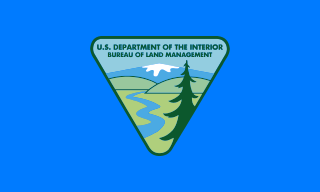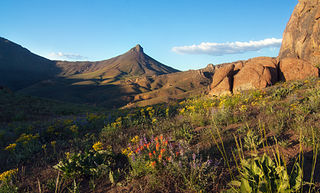
The Bureau of Land Management (BLM) is an agency within the United States Department of the Interior responsible for administering U.S. federal lands. Headquartered in Washington, D.C., the BLM oversees more than 247.3 million acres (1,001,000 km2) of land, or one-eighth of the United States's total landmass.

Bunkerville is a census-designated place in Clark County, Nevada, United States. The population was 1,303 at the 2010 census.

The Dann Sisters, Mary Dann (1923–2005) and Carrie Dann (1932–2021), were Western Shoshone elders who were spiritual leaders, ranchers, and cultural, spiritual rights and land rights activists. They challenged the federal government over uses of their tribe's traditional land, in a case that reached the United States Supreme Court as U.S. v. Dann.

The Taylor Grazing Act of 1934 is a United States federal law that provides for the regulation of grazing on the public lands to improve rangeland conditions and regulate their use.

Grazing rights is the right of a user to allow their livestock to feed (graze) in a given area.
Kleppe v. New Mexico, 426 U.S. 529 (1976), was a United States Supreme Court decision that unanimously held the Wild and Free-Roaming Horses and Burros Act of 1971, passed in 1971 by the United States Congress to protect these animals from "capture, branding, harassment, or death", to be a constitutional exercise of congressional power. In February 1974, the New Mexico Livestock Board rounded up and sold 19 unbranded burros from Bureau of Land Management (BLM) land. When the BLM demanded the animals' return, the state filed suit claiming that the Wild Free-Roaming Horses and Burros Act was unconstitutional, claiming the federal government did not have the power to control animals in federal lands unless they were items in interstate commerce or causing damage to the public lands.

The Trout Creek Mountains are a remote, semi-arid Great Basin mountain range mostly in southeastern Oregon and partially in northern Nevada in the United States. The range's highest point is Orevada View Benchmark, 8,506 feet (2,593 m) above sea level, in Nevada. Disaster Peak, elevation 7,781 feet (2,372 m), is another prominent summit in the Nevada portion of the mountains.
Section 15 lands are public lands in the United States that lie outside designated grazing districts and are administered by the Bureau of Land Management (BLM) under Section 15 of the Taylor Grazing Act of 1934. The BLM authorizes livestock grazing on these lands by issuing leases to private parties.

August Ludwig Hormay (1907–1999) developed and applied the concept of the rest-rotation grazing management system in areas of the Western United States. Rest-rotation rangeland management system uses deferred grazing to manage increased plant reproduction and maintenance, while providing grazing lands for both livestock and wildlife. Gus Hormay's rest-rotation management system was developed to increase a healthy plant community, watershed, soil and wildlife habitat, while at the same time increasing livestock production. It has been in use in various forms since the mid-1960s as a rangeland management tool.

American Prairie is a prairie-based nature reserve in Central Montana, United States, on a shortgrass prairie ecosystem with migration corridors and native wildlife. This wildlife conservation area is being developed as a private project of the American Prairie Foundation (APF), a non-profit organization. As of 2024, the reserve habitat base covers a total 527,068 acres (213,297 ha). This includes 140,552 deeded acres and 386,516 leased acres from public land. The organization hopes to expand it greatly through a combination of both private and public lands.
The Pryor Mountains Wild Horse Range is a refuge for a historically significant herd of free-roaming mustangs, the Pryor Mountain mustang, feral horses colloquially called "wild horses", located in the Pryor Mountains of Montana and Wyoming in the United States. The range has an area of 39,650 acres (160.5 km2) and was established in 1968 along the Montana–Wyoming border as the first protected refuge dedicated exclusively for mustangs. It was the second feral horse refuge in the United States. About a quarter of the refuge lies within the Bighorn Canyon National Recreation Area. A group of federal agencies, led by the Bureau of Land Management, administers the range.

The Wild and Free-Roaming Horses and Burros Act of 1971 (WFRHBA), is an Act of Congress, signed into law by President Richard M. Nixon on December 18, 1971. The act covered the management, protection and study of "unbranded and unclaimed horses and burros on public lands in the United States."

In the Western United States and Canada, open range is rangeland where cattle roam freely regardless of land ownership. Where there are "open range" laws, those wanting to keep animals off their property must erect a fence to keep animals out; this applies to public roads as well. Land in open range that is designated as part of a "herd district" reverses liabilities, requiring an animal's owner to fence it in or otherwise keep it on the person's own property. Most eastern states and jurisdictions in Canada require owners to fence in or herd their livestock.

Management of free-roaming feral and semi-feral horses, on various public or tribal lands in North America is accomplished under the authority of law, either by the government of jurisdiction or efforts of private groups. In western Canada, management is a provincial matter, with several associations and societies helping to manage wild horses in British Columbia and Alberta. In Nova Scotia, and various locations in the United States, management is under the jurisdiction of various federal agencies. The largest population of free-roaming horses is found in the Western United States. Here, most of them are protected under the Wild and Free-Roaming Horses and Burros Act of 1971 (WFRH&BA), and their management is primarily undertaken by the Bureau of Land Management (BLM), but also by the U. S. Forest Service (USFS)
The 2014 Bundy standoff was an armed confrontation between supporters of cattle rancher Cliven Bundy and law enforcement following a 21-year legal dispute in which the United States Bureau of Land Management (BLM) obtained court orders directing Bundy to pay over $1 million in withheld grazing fees for Bundy's use of federally owned land adjacent to Bundy's ranch in southeastern Nevada.

Cliven D. Bundy is an American cattle rancher known for his role in the 2014 Bundy standoff. Bundy has advocated a philosophy opposed to what he views as federal government overreach. He is the father of Ammon Bundy, who in 2016 also led another armed standoff against the government, the occupation of the Malheur National Wildlife Refuge in Oregon.

Citizens for Constitutional Freedom (C4CF), later also known as People for Constitutional Freedom (P4CF), was the name taken on January 4, 2016, by an armed private U.S. militia that occupied the U.S. Fish and Wildlife Service's Malheur National Wildlife Refuge headquarters in the U.S. state of Oregon from January 2 to February 11, 2016. The leader of the organization was Ammon Bundy, son of Cliven D. Bundy, who engaged in a standoff with the federal government over grazing rights on federal land.

Ammon Edward Bundy is an American anti-government militant and activist who led the 2016 occupation of the Malheur National Wildlife Refuge in Oregon. He is the son of rancher Cliven Bundy, who was the central figure in the 2014 Bundy standoff in Nevada regarding unpaid grazing fees on federally-owned public land.
United States v. Hammond was a court case in Oregon, United States, culminating from 20-year-long legal disputes between Harney County ranchers Dwight Lincoln Hammond Jr., 73, his son Steven Dwight Hammond, 46, and federal officials. In 2012, both Hammonds were charged with several counts in relation to two fires in 2001 and 2006, and eventually convicted of two counts of arson on federal land. Knowing they would face the statutory minimum of five years, the men waived their right to appeal these convictions in exchange for dismissal of several unresolved charges. After this mid-trial agreement was entered, the Hammonds were sentenced to a few months in jail, which they served. In 2015, the United States Court of Appeals for the Ninth Circuit vacated these sentences because they were shorter than the statutory mandatory minimum. The Ninth Circuit remanded to the district court for resentencing. The district court subsequently re-sentenced both Hammonds to the mandatory minimum of five years in prison, with credit for time served.
Ryan C. Bundy is an American cattle rancher and former Independent candidate in Nevada's 2018 Gubernatorial Election. He is the brother of Ammon Bundy and the son of Cliven Bundy, who was a central figure in the 2014 Bundy standoff in Bunkerville, Nevada over his unpaid grazing fees on federally-owned public land. Ryan Bundy was noted as a participant and leader in both the 2014 Bundy standoff and the 2016 occupation of the Malheur National Wildlife Refuge in Oregon.













